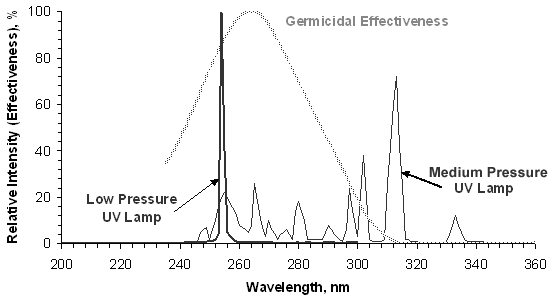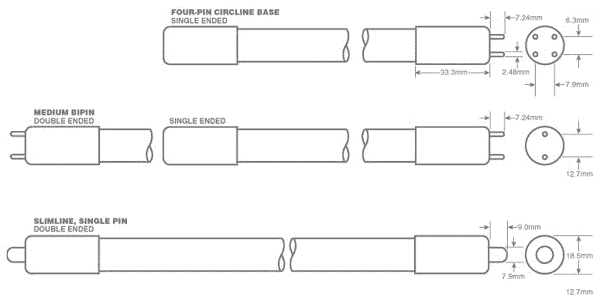 |
UV Lamps & Lamp Types | |
| Contact | Login | ||
| profile | uv systems | uv science facts | press releases | uv info | business programs |
UV Lamps & UVC Lamp Types
|
|
|
UVC Production by Germicidal UV Lamps
There are many types of lamps that artificially produce UV. There are UV lamps for tanning, for counterfeit money detection, blacklight stage lamps and lamps for mineral displays, lamps that produce Ozone and germicidal UV lamps. The focus of this text are the germicidal UV lamps, which emit shortwave UV light in the ultraviolet section of the spectrum known as UVC or germicidal UV. There is more information on UV in the UV Facts section. Here we will discuss the artificial UV production by UV lamps and the specs of the different types of UV lamps. People also refer to the UV lamps as UV bulbs as in regular light bulb. Even though bulb is not the correct term, replacement bulb, UV bulb or bulbs are widely accepted in the industry as a reference to the UV lamps.
UV Lamps – History and Development
UV light is artificially produced by mercury vapor low and medium pressure lamps. The low pressure lamps are most effective, because they emit most of the radiant energy in the germicidal wavelength at 253.7nm also known as the UVC part of the spectrum. This is the reason low pressure lamps are used in germicidal UV applications. These UV lamps could be hot cathode, cold cathode, Slimline, high output or amalgam in various lengths and pin configurations. The amalgam UV lamps contain solid amalgam “spots” (an amalgam is an alloy of mercury with another element, such as indium or gallium) that controls the mercury vapor pressure and extends the life of the UV lamps.

All germicidal UV lamps have secondary emissions, including small amounts of UVA, UVB, visible
light (above 400nm wavelength) and heat. The blue glow of the germicidal UV
lamps is not indicative to the effective germicidal output they produce – that
could be only determined with a properly calibrated UVC sensor and monitor.
As with all gas discharge lamps, the UV output of germicidal lamps is reduced
when the temperature of the lamp surface deviates from the optimum. The
performance data of the various UV lamp types and the influences of air or water
cooling play an important part in an effective and reliable UV disinfection. If
this is neglected it may lead to an inadequate UV installation.
For effective UV disinfection not only the temperature but the transparency or
transmittance of
the medium for UVC at 253.7nm wavelength is of great importance. The greater the
energy lost through absorption, the less energy remains to kill microbes. Tests
have shown that there is a reduction in the UV lamps disinfecting performance if
there is a high humidity level. For the effectiveness of UV water purification
systems transmittance of the water is very important.
The reducing factors must be taken under consideration when sizing the
UV lamps for an effective UV disinfecting process.
For air stream disinfection UV irradiation reflective materials with high UVC reflection
properties should be used as these materials will multiply the effectiveness of
the germicidal UV lamps.
Development of disinfection UV lamps started in the early nineteen-forties when
Westinghouse designed the Cold Cathode UV lamps. After that UVC lamps were tried out for disinfection everywhere –
surfaces, goods, water and air. The early extensive testing still applies today
as a basic knowledge, underlining the UV lamps technology.
UV Lamp Types
Cold Cathode Germicidal UV Lamps
The Cold Cathode Germicidal UV Lamps are instant-start lamps with a
cylindrical cold cathode type of electrode. These lamps are available in
different sizes and may be operated either from single lamp transformers or in
series trough medium of high voltage transformers. The UV lamps transformers are
also known as ballasts.
The combination of Vycor quartz tubing, used in most Cold Cathode lamps, and
sturdy electrode construction make lamp life relatively longer than other
types of UV lamps. Good ultraviolet output is maintained at lower temperatures
and lamp life is less affected by frequent starts.
Although the amount of radiant UV energy at 253.7nm wavelength emitted is the same
for both high and low ozone lamps, the high ozone lamps use a special Vycor
glass which transmits a controlled amount of radiation at 185nm, which
wavelength produces ozone. Ozone has deodorizing properties and is in itself a
bactericidal and fungicidal agent. However tests have shown that the Ozone has a
negative health effect if used indoors so the use of Ozone producing UV lamps is
not recommended for most applications.
The Cold Cathode ultraviolet germicidal lamp is used for general germicidal applications because of its
sturdy electrodes.
Hot Cathode Germicidal UV Lamps
The Hot Cathode Germicidal UV Lamps are similar in their operation to the standard fluorescent lamps. The Hot Cathode UV lamp operates from a ballast or transformer and requires a device such as the glow switch starter to preheat the electrodes in order to start the lamp. The electrodes, located at the ends of the lamp, are tungsten filaments coated with emission material and, under normal operation, govern the life of the lamp. In view of the fact that the life of the electrodes is shortened by frequent starts, the lamp life is rated according to the number of times the lamp is started. Operation at refrigerator temperatures may result in excessive lamp blackening and rapid depreciation in ultraviolet output. Starting of the Hot Cathode UV lamps at low temperature is sometimes unreliable and may require special equipment.
Slimline Germicidal Ultraviolet Lamps
The Slimline Germicidal Ultraviolet Lamp is an instant-start lamp, similar to
the Slimline fluorescent lamp. The Slimline UV lamps are available in low, high and
very high ozone types. The lamp life is governed by the electrode life and
number of starts.
Because of their high initial ultraviolet emission and good maintenance,
Slimline Germicidal ultraviolet lamps are well adapted for applications such as
indirect air irradiation, conveyor lines, surface sterilization and other
applications which require higher intensity UV lamps.
High Output Germicidal UV Lamps
A more recent addition to the UV lamps family is the type of High
Output germicidal UV lamps. The High Output lamps, usually indicated as HO UV
lamps, are the consequent result of applied knowledge in the latest lamp manufacturing processes. High UV output
over a great temperature range, a long life and consistent UV emission are
the pointers for the High Output UV lamps. Only high quality raw materials are
used in the lamp production. A fine tuning of the UV lamps with the automatic electronic
ballasts guarantees the lowest tolerance and a maximum UV stability.
With life duration of 12,000 hours and almost linear performance degradation, the
high output UV lamps are setting the standards for the development of high
performance UV systems.
The most important factor in using germicidal UV lamps is the
knowledge about their behavior under real working conditions (e.g. the effect of
air stream cooling). It is definitely not just the lamp performance under
laboratory conditions that count. Only in gaining this knowledge high quality
disinfection UV results can be achieved.
Taking the example of air stream cooling the High Output lamps do show their
real advantage. While classic UV lamps heavily depreciate under real working
conditions inside an air duct, this is not the case with the High Output UV
lamps.
Ultraviolet Light Emitting Diodes - UV LEDs
A completely new technology for UV production has started to emerge. This is the UV Light Emitting Diodes or UV LEDs. The UV LEDs are the next generation UV producing devises that will compete with the traditional UV lamps in the future. Some researchers claim that the UV LEDs have better characteristics surpassing the regular UV lamps. However at this time there is no UV LED equipment that can compete with the high output UV lamps in real world production conditions.
UV Lamp Shapes and Lamp Connectors
![]() There are many
UV lamp shapes: cylindrical lamps - like a glass tube, circular
tube, multi-coiled tube lamps, U-shaped lamps, double tubes or by-axial lamps.
The UV LED lamps are much smaller than the regular ultraviolet lamps and can be installed in
spaces that do not permit installation of regular UV lamps.
There are many
UV lamp shapes: cylindrical lamps - like a glass tube, circular
tube, multi-coiled tube lamps, U-shaped lamps, double tubes or by-axial lamps.
The UV LED lamps are much smaller than the regular ultraviolet lamps and can be installed in
spaces that do not permit installation of regular UV lamps.
All UV lamps are powered by ballasts that provide the starting electrical voltage to ionize the gas in the UV lamp and then limiting the current to the nominal level. Lamp ballasts can be either magnetic or electronic with the electronic ballasts dominating the marketplace. The ballasts can be voltage specific or multi-volt for 120V through 277V power input. The UV LEDs do not require ballasts for their operation.
The UV lamps have different types of connectors at one or both ends. The connectors can be single-pin, double pin (bi-pin) or four-pin in various patterns of the pins. The single and double pin connectors are located on both ends of the UV lamps requiring one lamp-holder on each end, while the four-pin connectors are single connectors at one end of the lamp. The 4-pin connectors can be made moisture-resistant.

UV Lamps Aging
The decrease in UV lamp output over the typical lifespan of 9,000 - 17,000 hours can vary between 15-40%. The manufacturer should be consulted for information on the end-of-life output of UV lamps. The decrease in UV output should be accounted for in the design phase such that the lamp output does not decrease to a point where the UV disinfection system becomes ineffective. The most conservative approach is to size the ultraviolet germicidal system based on the end-of-life of the lamp UV output. Selecting UV lamps based on end-of-life UV output will avoid the lamps aging problem.
The lamps should be kept clean and free of dust at all times. If dust accumulates on the lamp it will absorb the UV and convert it to heat, therefore lowering the effectiveness of the UV lamp. Appropriate filtration of the air prior to the UV lamps is recommended.
© 2002 - 2021
American Air & Water®, Inc.
843-306-0070
Privacy Statement and other Policies
ultraviolet | uv systems | uv facts | press releases | links and q&a | uv programscontact | login